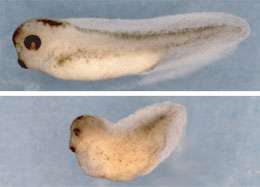For different species, different functions for embryonic microRNAs

(PhysOrg.com) -- When evolution has lucked into efficient solutions for life’s most fundamental problems, it adopts them as invaluable family heirlooms, passing them down as one species evolves into another. So it was reasonable to expect that a key regulator of embryonic development — a strand of RNA that shepherds stem cells through the process of differentiation — might play the same role in all vertebrates, from fish to people. New research, however, has shown that when it comes to microRNAs, what works for one animal may not work the same way in another.
Researchers at The Rockefeller University looked at the role of a family of microRNAs in the African clawed frog embryo and human embryonic stem cells, comparing their findings with earlier ones in fish, and found that although the genes for these microRNAs were identical across the three species, their function was not.
“The naďve assumption is that if we understand what these microRNAs do in a fish or in the frog, we can extrapolate to humans,” says Ali H. Brivanlou, head of the Laboratory of Molecular Vertebrate Embryology. “This study shows that this assumption is flawed when it comes to microRNAs.”
Discovered in the 1990s and first named in 2001, microRNAs are single strands of RNA that put the brakes on gene expression, halting the translation process that makes proteins. Postdoctoral associate Alessandro Rosa picked a particular family of these chemical brakes specific to vertebrates and known to operate only in the early stages of embryogenesis, shaping the fates of embryonic stem cells toward the various tissues and organs into which they will grow. The microRNAs Rosa studied regulate what’s known as the Nodal pathway, a process central to initial cell differentiation. The relative proportion of certain activator proteins — called Nodals — and inhibitory proteins — Lefties — determine how active the pathway is. Rosa believed that this particular group of microRNAs disrupts the Lefties, helping to sustain the Nodal pathway, which is central to development. And his research, published last month in Developmental Cell, bore that out.
Using a chemical technique to block the microRNA in frog embryos, Rosa found that the embryos failed to develop the upper, or dorsal, and anterior portions of their growing bodies, including the tissues that would eventually become neurons and eyes. Instead, their ventral part was expanded, forming a belly-like protrusion underneath. Performing the same experiment on human embryonic stem cells, he discovered a slightly different effect: Markers for tissues fated to develop into the nervous system — the neuroectoderm — were up, and markers for the mesendoderm — the precursor of bones, muscles and blood, among other things — were down.
The big difference, the researchers found, was what the microRNAs targeted in each species. Previous experiments had shown that this particular microRNA targets both the Nodals and the Lefties in zebra fish. Rosa found that the same microRNA in both frogs and humans also targets the Lefties. But in humans, the microRNA does not directly target the Nodal protein, and in frogs, it targets only the pathway’s weakest elements.
“Although the microRNAs are evolutionarily conserved, their target changes across species. These are genetic tools that nature has invented, much like the screwdriver, to build different things for different species,” Brivanlou says.
More information: Developmental Cell 16(4) 517-527 (April 21, 2009), The miR-430/427/302 Family Controls Mesendodermal Fate Specification via Species-Specific Target Selection, Alessandro Rosa, Francesca M. Spagnoli and Ali H. Brivanlou
Provided by Rockefeller University (news : web)













